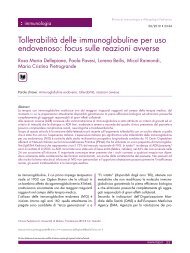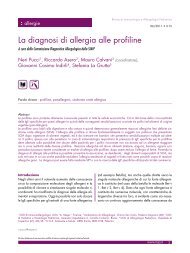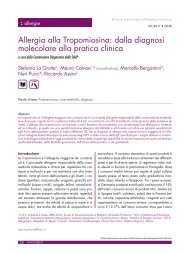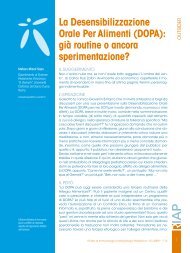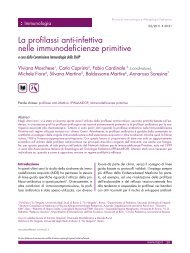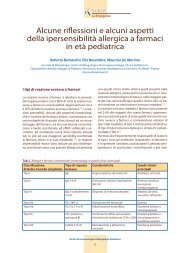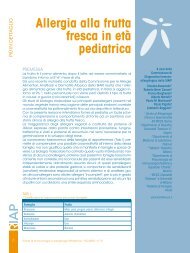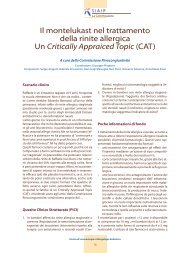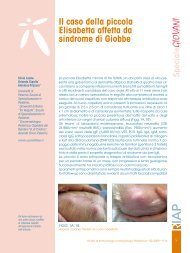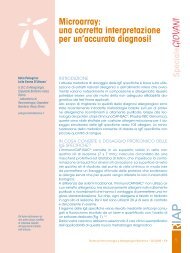Come si dovrebbe fare e valutare il Test di Provocazione ... - RIAP
Come si dovrebbe fare e valutare il Test di Provocazione ... - RIAP
Come si dovrebbe fare e valutare il Test di Provocazione ... - RIAP
You also want an ePaper? Increase the reach of your titles
YUMPU automatically turns print PDFs into web optimized ePapers that Google loves.
TEST DI PROVOCAZIONE ORALE PER ALIMENTI<br />
16<br />
75 Bock SA, Atkins FM. Patterns of food hypersen<strong>si</strong>tivity during<br />
<strong>si</strong>xteen years of double-blind, placebo-controlled food<br />
challenges. J Pe<strong>di</strong>atr 1990;117:561-7.<br />
76 Niggemann B, Sielaff B, Beyer K, Binder C, Wahn U. Outcome<br />
of double-blind, placebo-controlled food challenge<br />
tests in 107 ch<strong>il</strong>dren with atopic dermatitis. Clin Exp Allergy<br />
1999;29:91-6.<br />
77 Mofi <strong>di</strong> S, Bock SA, eds. A Health Profes<strong>si</strong>onal’s Guide to Food<br />
Challenges. Fairfax, VA: The Food Allergy & Anaphylaxis Network<br />
2004.<br />
78 Sampson HA, Albergo R. Comparison of results of skin tests,<br />
RAST, and double-blind, placebo-controlled food challenges<br />
in ch<strong>il</strong>dren with atopic dermatitis. J Allergy Clin Immunol<br />
1984;74:26-33.<br />
79 Niggemann B, Wahn U, Sampson HA. Proposals for standar<strong>di</strong>zation<br />
of oral food challenge tests in infants and ch<strong>il</strong>dren.<br />
Pe<strong>di</strong>atr Allergy Immunol 1994;5:11-3.<br />
80 American College of Allergy and Immunology. Guidelines<br />
for study of adverse reactions to food. Ann Allergy<br />
1991;67:299-300.<br />
81 Martelli A, Bouygue GR, Isoar<strong>di</strong> P, Marelli O, Sarratud T, Fiocchi<br />
A. Oral food challenges in ch<strong>il</strong>dren in Italy. Allergy<br />
2005;60:907-11.<br />
82 Rance F, Kanny G, Dutau G, Moneret-Vautrin D. Food hypersen<strong>si</strong>tivity<br />
in ch<strong>il</strong>dren: clinical aspects and <strong>di</strong>stribution of<br />
allergens. Pe<strong>di</strong>atr Allergy Immunol 1999;10:33-8.<br />
83 Rance F, Dutau G. Labial food challenge in ch<strong>il</strong>dren with<br />
food allergy. Pe<strong>di</strong>atr Allergy Immunol 1997;8:41-4.<br />
84 Taylor SL, Hefl e SL, Bindslev-Jensen C, Bock SA, Burks AW<br />
Jr, Christie L, et al. Factors affecting the determination of<br />
threshold doses for allergenic foods: how much is too<br />
much? J Allergy Clin Immunol 2002;109:24-30.<br />
85 Crevel RW, Ballmer-Weber BK, Holzhauser T, Hourihane<br />
JO, Knulst AC, Mackie AR,, et al. Thresholds for food allergens<br />
and their value to <strong>di</strong>fferent stakeholders. Allergy<br />
2008;63:597-609.<br />
86 Niggemann B, Reibel S, Roehr C, Felger D, Ziegert M, Sommerfeld<br />
C, et al. Pre<strong>di</strong>ctors of po<strong>si</strong>tive food challenge outcome<br />
in non-IgE-me<strong>di</strong>ated reactions to food in ch<strong>il</strong>dren with<br />
atopic dermatitis. J Allergy Clin Immunol 2001;108:1053-8.<br />
87 Sicherer SH, Morrow EH, Sampson HA. Dose-response in<br />
double-blind, placebo-controlled oral food challenges<br />
in ch<strong>il</strong>dren with atopic dermatitis. J Allergy Clin Immunol.<br />
2000;105:582-6.<br />
88 Wen<strong>si</strong>ng M, Penninks AH, Hefl e SL, et al. The range of minimum<br />
provoking doses in hazelnut-allergic patients as determined<br />
by double-blind, placebo-controlled food challenges.<br />
Clin Exp Allergy 2002;32:1757-62.<br />
89 W<strong>il</strong>liams LW, Bock SA. Skin testing and food challenges in<br />
allergy. Clin Rev Allergy Immunol 1999;17:323-38.<br />
90 Kok EE, Meijer Y, Kentie PA, Pasmans SGM, Knulst AC, Hoekstra<br />
MO. Oropharyngeal symptoms pre<strong>di</strong>ct objective symptoms<br />
in double-blind placebo-controlled food challenges<br />
to cow’s m<strong>il</strong>k. Allergy 2009;64:1226-7.<br />
91 Niggeman B, Beyer K. Pitfall in double blind placebo controlled<br />
food challenge. Allergy 2007;62:729-32.<br />
92 Sampson HA, Mc Casc<strong>il</strong>l CC. Food hypersen<strong>si</strong>tivity and<br />
atopic dermatitis. Evaluation of 113 patients. J Pe<strong>di</strong>atr<br />
1985;107:669-75.<br />
93 Burks AW, Sampson HA. Diagnostic approaches to the patient<br />
with suspected food allergies. J Pe<strong>di</strong>atr 1992;121:S64-<br />
S71.<br />
94 Huijbers GB, Colen AA, Jansen JJ, Kar<strong>di</strong>naal AF, Vlieg-Boerstra<br />
BJ, Martens BP. Masking foods for food challenge: practical<br />
aspects of masking foods for adouble-blind, placebocontrolled<br />
food challenge. J Am Diet Assoc 1994;94:645-9.<br />
95 Busse PJ, Nowak-Wegrzyn AH, Noone SA, Sampson HA,<br />
Sicherer SH. Recurrent peanut allergy. N Engl J Med<br />
2002;347:1535-6.<br />
96 Fleischer DM, Conover-Walker MK, Christie L, Burks AW, Wood<br />
RA. Peanut allergy: recurrence and its management. J Allergy<br />
Clin Immunol 2004;114:1195-201.<br />
97 Eigenmann PA, Caubet JC, Zamora SA. Continuing foodavoidance<br />
<strong>di</strong>ets after negative food challenges. Pe<strong>di</strong>atr<br />
Allergy Immunol 2006;17:601-5.<br />
98 Devenney I, Norrman G, Oldaeus G, Stromberg L, Falth-<br />
Magnusson K. A new model for low-dose food challenge<br />
in ch<strong>il</strong>dren with allergy to m<strong>il</strong>k or egg. Acta Pae<strong>di</strong>atrica<br />
2006;95:1133-9.<br />
99 Edwards HE. Oral desen<strong>si</strong>tization in food allergy. Cana<strong>di</strong>an<br />
Me<strong>di</strong>cal Association Journal 1940;234-6.<br />
100 Finkelstein A. Kuhm<strong>il</strong>ch als Ursache akuter Ernährungsstörungen.<br />
Sauglingen Monat für Kinderhe<strong>il</strong> 1905;4:65-72.<br />
101 Patriarca G, Nucera E, Roncallo R, Pollastrini E, Bartolozzi F,<br />
De Pasquale T, et al. Oral desen<strong>si</strong>tizing treatment in food<br />
allergy: clinical and immunological results. Aliment Pharmacol<br />
Ther 2003;17:459-65.<br />
102 Meglio P, Bartone E, Plantamura M, Arabico E, Giampietro<br />
PG. A protocol for oral desen<strong>si</strong>tization in ch<strong>il</strong>dren with IgEme<strong>di</strong>ated<br />
cow’s m<strong>il</strong>k allergy. Allergy 2004;59:980-7.<br />
103 Enrique E, Pineda F, Malek T, Bartra J, Basagaña M, Tella R,<br />
et al. Sublingual immunotherapy for hazelnut food allergy:<br />
a randomized, double-blind, placebo-controlled study with<br />
a standar<strong>di</strong>zed hazelnut extract. J Allergy Clin Immunol<br />
2005;116:1073-9.<br />
104 Fernandez Rivas M, Garrido Fernandez S, Nadal JA, Alonso<br />
Diaz de Durana MD, Garcia BE Gonzalez-Manchebo E, et<br />
al. Randomized double-blind, placebo-controlled trial of<br />
sublingual immunotherapy with Pru p3 quantifi ed peach<br />
extract. Allergy 2009;64:876-83.<br />
105 Morisset M, Moneret-Vautrin DA, Guenard L, Cuny JM, Frentz<br />
P, Hatahet R, et al. Oral desen<strong>si</strong>tization in ch<strong>il</strong>dren with m<strong>il</strong>k<br />
and egg allergies obtains recovery in a <strong>si</strong>gnifi cant proportion<br />
of cases. A randomized study in 60 ch<strong>il</strong>dren with cow’s<br />
m<strong>il</strong>k allergy and 90 ch<strong>il</strong>dren with egg allergy. Eur Ann Allergy<br />
Clin Immunol 2007;39:12-9.<br />
106 Staden U, Rolink-Werninghaus C, Brewer F, Wahn U, Niggemann<br />
B, Beyer K. Specifi c oral tolerance induction in food<br />
allergy in ch<strong>il</strong>dren: effi cacy and clinical pattern of reaction.<br />
Allergy 2007;62:1261-9.<br />
107 Longo G, Barbi E, Berti I, Meneghetti R, Pittalis A, Ronfani L, et<br />
al. Specifi c oral tolerance induction in ch<strong>il</strong>dren with very severe<br />
cow’s m<strong>il</strong>k-induced reactions. J Allergy Clin Immunol<br />
2008;121:343-7.<br />
108 Skripak JM, Nash SD, Rowley H, Brereton NH, Oh S, Ham<strong>il</strong>ton<br />
RG, et al. A randomized, double blind, plecebo-controlled<br />
study of m<strong>il</strong>k oral immunotherapy for cow’s m<strong>il</strong>k allergy. J<br />
Allergy Clin Immunol 2007;120:1172-7.<br />
109 Calvani M, Giorgio V, Miceli Sopo S. Specifi c oral tolerance<br />
induction for food. A systematic review. Eur Ann Allergy Clin<br />
Immunol 2009; in press<br />
110 Yokum MW, Butterfi eld JH, Klein JS, Volcheck GW, Schroder<br />
DR, S<strong>il</strong>verstein MD. Epidemiology of anaphylaxis in Olmsted<br />
County: a population-based study. J Allergy Clin Immunol<br />
1999;104:452-6.<br />
111 Calvani M, Di Lallo D, Spinelli A, Polo A, Zicari AM, Zappala<br />
D. Hospitalizations for pe<strong>di</strong>atric anaphylaxis. Int J Immunopathol<br />
Pharmacol 2008;21:975-81.<br />
112 Peng MM, Jick H. A population-based study of the incidence,<br />
cause and severity of anaphylaxis in the United<br />
Kingdom. Arch Int Med 2004;164:317-9.<br />
113 Beyer K, Wahn U. Immunotherapy for food allergy in ch<strong>il</strong>dren.<br />
Curr Opin Allergy Clin Immunol 2008;8:553-6.<br />
114 Sampson HA. Anaphylaxis and Emergency treatment.<br />
Pe<strong>di</strong>atrics 2003;111:1601-8.<br />
115 Simons FER, Gu X, Simons KJ. Epinephrine absorption in<br />
adults: intramuscular versus subcutaneous injection. J Allergy<br />
Clin Immunol 2001;108:871-3.<br />
116 Kemp SF, Lockey RF, Simons FER, on behalf of the World Allergy<br />
Organization ad hoc Committee on Epinephrine in<br />
Anaphylaxis. Epinephrine: the drug of choice for anaphylaxis.<br />
A Statement of the World Allergy Organization. Allergy<br />
2008;63:1061-70.<br />
117 Clark AT, Ewan PW. The prevention and management of<br />
anaphylaxis in ch<strong>il</strong>dren. Current Pae<strong>di</strong>atrics 2002;12:370-5.<br />
118 Nolan J, Baskett P. ERC Guidelines for Resuscitation 2005.<br />
Oxford: Elsevier 2005.<br />
119 Lieberman P, Kemp SF, Oppenheimer J, Lang DM, Bernstein<br />
IL, Nicklas RA, et al. The <strong>di</strong>agno<strong>si</strong>s and management of anaphylaxis:<br />
an updated practice parameter. J Allergy Clin<br />
Immunol 2005;115:s483-523.<br />
<strong>Come</strong> <strong>si</strong> <strong>dovrebbe</strong> <strong>fare</strong> e <strong>valutare</strong> <strong>il</strong> <strong>Test</strong> <strong>di</strong> provocazione orale per alimenti. Norme pratiche <strong>di</strong> comportamento



